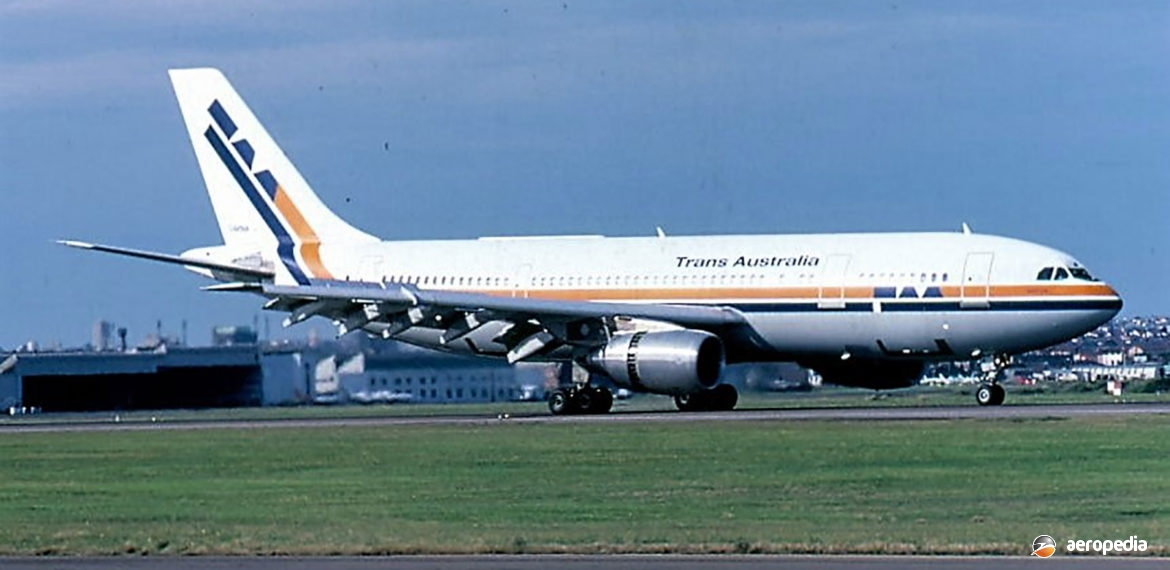Photograph:
Airbus A300B4-203 VH-TAA (c/n 134) at Mascot, NSW in December 1995 (David C Eyre)
Country of origin:
International Consortium
Description:
Medium-haul commercial transport
Power Plant:
Two 51,000 lbst General Electric CF6-50C turbofans
Specifications:
- Wingspan: 44.84 m (147 ft 1¼ in)
- Length: 53.62 m (175 ft 11 in)
- Height: 16.53 m (54 ft 2 in)
- Wing area: 260 m² (2,799 sq ft)
- Max cruising speed at 9,185 m (28,000 ft): 930 km/h (578 mph)
- Economical cruising speed at 9,450 m (31,000 ft): 839 km/h (540 mph)
- Long range cruising speed at 10,060 m (33,000 ft): 839 km/h (521 mph)
- Range with max payload: 6,428 km (3,994 miles)
- Empty weight: 85,060 kg (194,130 lb)
- Loaded weight: 157,500 kg (347,200 lb)
History:
On 26 September 1967 a Memorandum of Understanding was signed by the British, French and German Governments to cover the development of an Airbus-type aircraft with Rolls Royce RB207 engines. However, because of the absence of firm airline orders, the British Government withdrew in 1969, although Hawker Siddeley remained as a partner, designing and constructing the wing. France and Germany confirmed their intention to proceed, and in May that year shares in the programme were acquired by Spain and The Netherlands. Final assembly was set up at the Aerospatiale facility at Toulouse in France and the first aircraft completed to A300B1 standard (F-WUAB) was flown on 28 October 1972, the second on 5 February 1973. The first A300B2 (the production version) flew on 28 June 1973, certification being received on 15 March 1974.
In typical layout the A300 carried 281 passengers, eight abreast, whilst in a high-density layout up to 345 passengers, nine abreast, could be accommodated. Designed for short-to-medium ranges, the A300 was developed in a number of versions to meet customer requirements. The A300B2 had the fuselage stretched by 2.65 m (8 ft 9 in) and the gross weight was increased. This model entered service with Air France, Air Inter, Lufthansa and other European airlines.
The next variant was the A300B4, similar to the A300B2 but with more fuel capacity to permit a greater range. Consequently up-rated CF6-50C engines were installed. The first aircraft of this variant flew on 26 December 1974. The A300B2-200 had Krueger leading-edge flaps and a greater payload; the A300B4-100 was a long-range variant; and the A300C was a convertible, this featuring a main deck freight door behind the wing on the left hand side. Later in the production life of the type a two-crew flightdeck was offered.
Next variant was the A300-600 with 59,000 lbst CF6-80C2A1 turbofans, or Pratt & Whitney PW4156 turbofans, and incorporated a number of improvements, including a two-crew flight deck, increased range, and an EFIS cockpit. This was developed into the long-range A300-600R, the first flight of which was on 9 December 1987. Convertible freight/passenger variants were made available. The A300F4-600 was built as a pure freighter.
In January 1980 Trans Australia Airlines (later Australia Airlines and Qantas) ordered four A300s with options on a further two. These were A300B4-203s seating 260 passengers. The first VH-TAA (c/n 134 – ex F-WZEJ) entered service in June 1981 and the others VH-TAB (c/n 151 – ex F-WZME); VH-TAC (c/n 157 – ex F-WZNG); and VH-TAD (c/n 196 – ex F-WZET) followed. One option VH-TAE ( c/n 218 – ex F-WZMZ) was taken up in December 1982.
As part of the contract, British Aerospace and Hawker de Havilland at Bankstown, NSW manufactured components for the A310, this including construction of 150 sets of wingspar ribs. Eventually Australian Airlines found it had too much capacity so one A300 was leased to a German company, and a second to Air Niugini. VH-TAB was later sold to TOA Domestic Airlines in Japan. In the late 1990s the other four A300s were also sold to a freight operator in Europe.
In 1990 Compass Airlines commenced service, putting into service four A300B4-605Rs VH-YMJ (c/n 540); VH-YMK (c/n 556); VH-YMA (c/n 584); and VH-YMB (c/n 603). Further examples were expected to be imported, registrations VH-YMC, VH-YMD and VH-YME being reserved. In the event the airline ceased operations on 20 December 1991 and the four aircraft were exported overseas.
Further examples have been registered in Australia. Owned by Nordstress, a leasing company, these aircraft, A300-B4-622Bs, have been stored in Australia or overseas, and have been placed on the Australian Civil Aircraft Register in between leases to overseas operators. These included VH-IGF (c/n 613), VH-IWD (c/n 611), VH-BWF (c/n 633), VH-EFW² (c/n 630) which became A7-ABP in 2001 and returned to become VH-JBN; and VH-CLM (c/n 688).
Production concluded in July 2007 after 562 aircraft had been delivered, the last aircraft being delivered on 12 July to FedEx in the USA.

